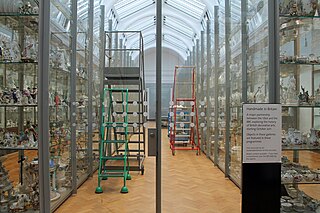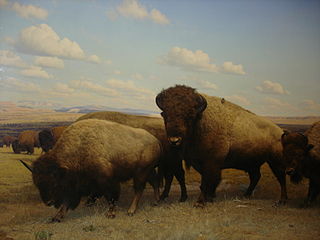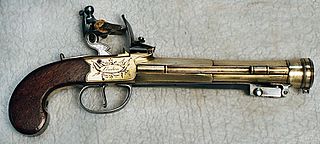Related Research Articles

Ivory is a hard, white material from the tusks and teeth of animals, that consists mainly of dentine, one of the physical structures of teeth and tusks. The chemical structure of the teeth and tusks of mammals is the same, regardless of the species of origin, but ivory contains structures of mineralised collagen. The trade in certain teeth and tusks other than elephant is well established and widespread; therefore, "ivory" can correctly be used to describe any mammalian teeth or tusks of commercial interest which are large enough to be carved or scrimshawed.

Scrimshaw is scrollwork, engravings, and carvings done in bone or ivory. Typically it refers to the artwork created by whalers, engraved on the byproducts of whales, such as bones or cartilage. It is most commonly made out of the bones and teeth of sperm whales, the baleen of other whales, and the tusks of walruses.

With respect to cultural property, conservation science is the interdisciplinary study of the conservation of art, architecture, technical art history and other cultural works through the use of scientific inquiry. General areas of research include the technology and structure of artistic and historic works. In other words, the materials and techniques from which cultural, artistic and historic objects are made.

The conservation and restoration of parchment constitutes the care and treatment of parchment materials which have cultural and historical significance. Typically undertaken by professional book and document conservators, this process can include preventive measures which protect against future deterioration as well as specific treatments to alleviate changes already caused by agents of deterioration.
Conservation and restoration of movable cultural property is a term used to denote the conservation of movable cultural property items in libraries, archives, museums and private collections. Conservation encompasses all the actions taken toward the long-term preservation of cultural heritage. Activities include examination, documentation, treatment, and preventive care, which is supported by research and education. Object conservation is specifically the actions taken to preserve and restore cultural objects. The objects span a wide range of materials from a variety of cultures, time periods, and functions. Object conservation can be applied to both art objects and artifacts. Conservation practice aims to prevent damage from occurring, a process known as 'preventive conservation'. The purpose of preventive conservation is to maintain, and where possible enhance, the condition of an object, as well as managing deterioration risks, such as handling and environmental conditions. Historically, object conservation was focused on the category of fine arts but now many different types of objects are conserved. Each type of object material, typically denoted by organic or inorganic then the specific medium, requires a specialized professional conservator and often requires collaborative work between museum staff, scientists, and conservators.

Conservation and restoration of glass objects is one aspect of conservation and restoration of cultural heritage. The nature and varying composition of the material, and the variety of types of object made from it, demand certain specialized techniques. The conservator needs to be aware of "agents of deterioration" presenting particular risk to glass objects, and how to prevent or counteract their effects. Relevant education and training is available in certain countries through museums, conservation institutes and universities.

Collection maintenance is an area of collections management that consists of the day-to-day hands on care of collections and cultural heritage. The primary goal of collections maintenance or preventive conservation is to prevent further decay of cultural heritage by ensuring proper storage and upkeep including performing regular housekeeping of the spaces and objects and monitoring and controlling storage and gallery environments. Collections maintenance is part of the risk management field of collections management. The professionals most involved with collections maintenance include collection managers, registrars, and archivists, depending on the size and scope of the institution. Collections maintenance takes place in two primary areas of the museum: storage areas and display areas.

The conservation and restoration of shipwreck artifacts is the process of caring for cultural heritage that has been part of a shipwreck. Oftentimes these cultural artifacts have been underwater for a great length of time. Without conservation, most artifacts would perish and important historical data would be lost. In archaeological terms, it is usually the responsibility of an archaeologist and conservator to ensure that material recovered from a shipwreck is properly cared for. The conservation phase is often time-consuming and expensive, which is one of the most important considerations when planning and implementing any action involving the recovery of artifacts from a shipwreck.

The conservation and restoration of clocks refers to the care given to the physical and functional aspects of time measuring devices featuring "moving hands on a dial face" exclusive of watches. Care for clocks constitutes regulating the external environment, cleaning, winding, lubrication, pest-management, and repairing or replacing mechanical and aesthetic components to preserve or achieve the desired state as specified by the owner. Clocks are typically composed of multiple types of materials such as wood, metal, paint, plastic, etc., which have unique behaviors and environmental interactions, making treatment options complex. The materials used and the complexity of clockwork warrant having a Horological Conservator complete the work.
The conservation and restoration of lacquerware prevents and mitigates deterioration or damage to objects made with lacquer. The two main types of lacquer are Asian, made with sap from the Urushi tree, and European, made with a variety of shellac and natural resins. Lacquer can be damaged by age, light, water, temperature, or damaged substrate.

Conservation-restoration of bone, horn, and antler objects involves the processes by which the deterioration of objects either containing or made from bone, horn, and antler is contained and prevented. Their use has been documented throughout history in many societal groups as these materials are durable, plentiful, versatile, and naturally occurring/replenishing.

The conservation and restoration of paintings is carried out by professional painting conservators. Paintings cover a wide range of various mediums, materials, and their supports. Painting types include fine art to decorative and functional objects spanning from acrylics, frescoes, and oil paint on various surfaces, egg tempera on panels and canvas, lacquer painting, water color and more. Knowing the materials of any given painting and its support allows for the proper restoration and conservation practices. All components of a painting will react to its environment differently, and impact the artwork as a whole. These material components along with collections care will determine the longevity of a painting. The first steps to conservation and restoration is preventive conservation followed by active restoration with the artist's intent in mind.

The conservation and restoration of woodblock prints, is the process of caring for and repairing images made from a specific printing process involving using wooden reliefs to stamp or imprint an image onto paper. The process of creating woodblock prints as Asian examples are known, or woodcuts as Western examples are called, has been known for many centuries, and many older prints have experienced aging and deterioration of the paper and colorants used.
The conservation and restoration of film is the physical care and treatment of film-based materials. These include photographic film and motion picture film stock.

The conservation of taxidermy is the ongoing maintenance and preservation of zoological specimens that have been mounted or stuffed for display and study. Taxidermy specimens contain a variety of organic materials, such as fur, bone, feathers, skin, and wood, as well as inorganic materials, such as burlap, glass, and foam. Due to their composite nature, taxidermy specimens require special care and conservation treatments for the different materials.
The conservation-restoration of panel paintings involves preventive and treatment measures taken by paintings conservators to slow deterioration, preserve, and repair damage. Panel paintings consist of a wood support, a ground, and an image layer. They are typically constructed of two or more panels joined together by crossbeam braces which can separate due to age and material instability caused by fluctuations in relative humidity and temperature. These factors compromise structural integrity and can lead to warping and paint flaking. Because wood is particularly susceptible to pest damage, an IPM plan and regulation of the conditions in storage and display are essential. Past treatments that have fallen out of favor because they can cause permanent damage include transfer of the painting onto a new support, planing, and heavy cradling. Today's conservators often have to remediate damage from previous restoration efforts. Modern conservation-restoration techniques favor minimal intervention that accommodates wood's natural tendency to react to environmental changes. Treatments may include applying flexible battens to minimize deformation or simply leaving distortions alone, instead focusing on preventive care to preserve the artwork in its original state.

The conservation and restoration of wooden artifacts refers to the preservation of art and artifacts made of wood. Conservation and restoration in regards to cultural heritage is completed by a conservator-restorer.

The conservation and restoration of quilts refers to the processes involved in maintaining the integrity of quilts and/or restoring them to an acceptable standard so that they may be preserved for future generations. Quilts have been produced for centuries, as utilitarian blankets, decorations, family heirlooms, and now treasured museum collections objects. Quilts are three-layered textile pieces with a decorated top, a back, and a filler in the middle. The composite nature of these objects creates an interesting challenge for their conservation, as the separate layers can be made of different textile materials, multiple colors, and therefore, varying degrees of wear, tear, and damage.

The conservation and restoration of historic firearms is preventative care, damage repair, stabilization, replacement of missing components, and potentially the return of the firearm to firing capabilities. It requires an understanding of the different types of historic firearms and knowledge in the care and treatment of organic and inorganic materials, as firearms are composed of many types of materials, from wood to metal, that are fitted together.

The 'ten agents of deterioration' are a conceptual framework developed by the Canadian Conservation Institute (CCI) used to categorise the major causes of change, loss or damage to cultural heritage objects. Also referred to as the 'agents of change', the framework was first developed in the late 1980s and early 1990s. The defined agents reflect and systematise the main chemical and physical deterioration pathways to which most physical material is subject. They are a major influence on the applied practice of conservation, restoration, and collection management, finding particular use in risk management for cultural heritage collections.
References
- ↑ "The History of the Ivory Trade". National Geographic Society. 2013-02-25. Retrieved 2019-03-31.
- ↑ "To Save An Elephant" by Allan Thornton & Dave Currey, Doubleday 1991 ISBN 0-385-40111-6
- 1 2 Craft, Meg (1992). Harriet Whelchel (ed.). Caring for your collections. New York: Harry N. Abrams, Incorporated. pp. 96–107. ISBN 0-8109-2558-3.
- 1 2 3 4 5 6 7 8 9 10 11 12 Hornbeck, Stephanie (2014). "Ivory: identification and regulation of a precious material". National Museum of African Art Conservation Lab. Smithsonian National Museum of African Art: 1–10.
- 1 2 3 4 5 6 7 8 9 10 11 Tom Stone (2014). "Care of ivory, bone, horn, and antler - Canadian Conservation Institute (CCI) Notes 6/1". Minister of Public Works and Government Services Canada. Archived from the original on 2016-05-02. Retrieved 2017-04-13.
- 1 2 3 4 5 6 U.S. Fish and Wildlife Service Forensics Lab (2010). "U.S. Fish and Wildlife Services Forensics Laboratory". U.S. Fish and Wildlife Services.
- 1 2 3 Institute, Canadian Conservation (2017-09-14). "Care of Ivory, Bone, Horn and Antler – Canadian Conservation Institute (CCI) Notes 6/1". aem. Retrieved 2019-04-01.
- 1 2 3 4 5 6 7 Smithsonian. "THE CARE AND HANDLING OF IVORY OBJECTS". Smithsonian Museum Conservation Institute.
- 1 2 3 4 5 6 Storch, Paul S. (2004). "Bone, Antler, Ivory, and Teeth". In Sherelyn Ogden (ed.). Caring for American Indian objects: a practical and cultural guide. St.Paul, MN: Minnesota Historical Society. ISBN 0-87351-505-6.
- ↑ Pouliot, Bruno (2009). "Organic Materials". In Onie Rollins (ed.). The Winterthur Guide to caring for your collection. Delaware: The Henry Francis Du Pont Winterthur Museum, Inc. ISBN 978-0-912724-52-2.
- 1 2 3 4 Passmore, Emma; Ambers, Janet (2012). "Hidden, looted, saved: the scientific research and conservation of a group of Bergram Ivories from the National Museum of Afghanistan" (PDF). Technical Research Bulletin. The British Museum. 6: 33–46.
- ↑ Ward, Gerald W.R., ed. (2008). The Grove Encyclopedia of Materials and Techniques in Art. Oxford University Press. pp. 299–301. ISBN 978-0-19-531391-8.
- ↑ Vanessa Muros; Yuri Yanchyshyn; Randy S. Wilkinson; Jean Portell; Stephanie Hornbeck (2011). "AIC Wiki Ivory". Object Specialty Group Conservation Wiki.
- ↑ Objects Specialty Group of the American Institute for Conservation of Historic and Artistic Works
- 1 2 3 4 5 6 Ben Phelan (22 June 2015). "Overview of Current Ivory Law". PBS.